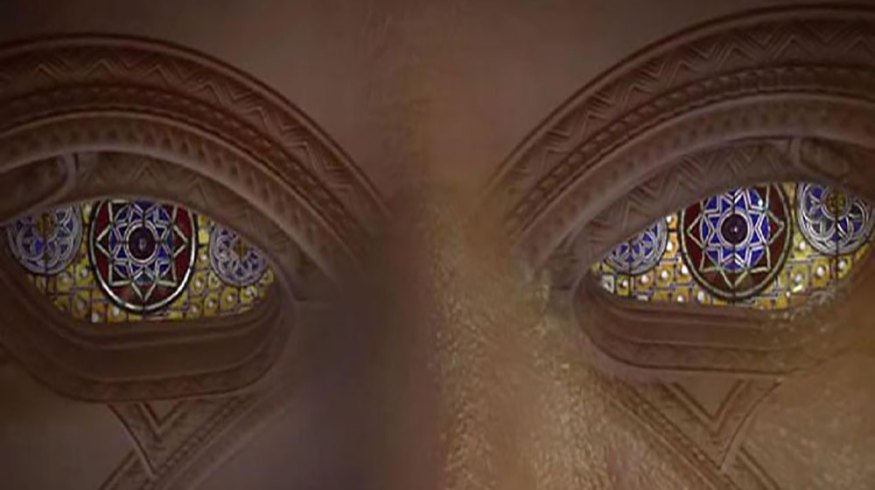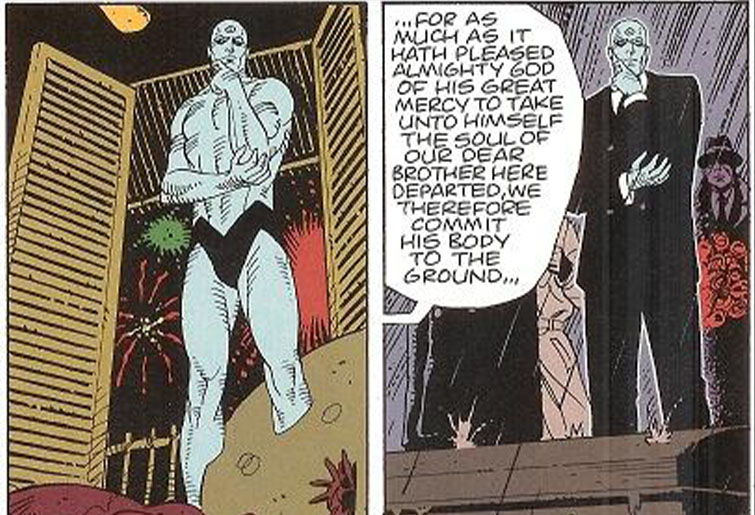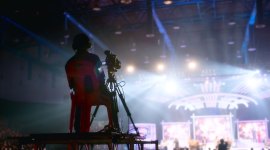
Cinematography Tips from Watchmen DP Gregory Middleton
Gregory Middleton shares some behind-the-scenes stories about the cinematography behind Watchmen — as well as some insights for aspiring filmmakers.
We sat down with the brilliant director of photography Gregory Middleton, who was the eye behind this season’s most powerful episodes of HBO’s Watchmen. If you haven’t been watching, then you’re missing out on some of the most compelling content currently on the small screen.
Here’s what he had to say.
(Warning: SPOILERS ahead.)
PremiumBeat: What kind of cameras, lens packages, and other gear did you use on Watchmen?
Gregory Middleton: I joined the show on episode two, after the pilot was shot. I stuck to the same camera type they used on the pilot, which was an Alexa mini. That was our main camera.
So, we carried two of those, and I switched up our lens package a little bit, and we experimented with a couple of different formats. We shot 178 spherical, and I used Cooke S5 primes. We also carried a small selection of anamorphic lenses, mainly so we could have some more selective focus and change the background focus a little bit for certain types of shots.
We were really trying to emphasize the kind of graphic nature in composition and take some elements from the comic — using selective focus was a good way to do that. We also carried some sliding diopters that let us selectively defocus areas of the frame or selectively increase the focus distance and maybe have a large foreground object in focus as well as someone in the background.
A good example is Old Man Will in the second episode, when he’s being interrogated by Sister Night, and she takes the memory pills. You don’t know what they’re about yet at that point, and she puts them on the table in the foreground.
You have a nice shot of him and the pills, and he’s asking for his pills back and explaining what they are, and they’re both in focus. That’s very much a graphic-novel style of comic frame — everything in the graphic novel is obviously sharp because everything is in focus the way it’s drawn. We wanted to be able to selectively go in and out of that type of look. So that’s basically the origins of the lens package. Everything else is pretty standard — the usual types of tools.
PB: Let’s get into pre-production. Episode 6, “This Extraordinary Being,” is a smooth, linear, seamless experience. The episode is packed with oners and incredible transitions. How’d you go about blocking out those shots?
GM: We tried to do everything live. A big part of the pre-production of this episode was planning all of these transitions and designing all these very elaborate shots. You can’t make them up on the day and have any hope of executing them properly. Some of them involve, you know, 360-lighting cues and things like that. Also, the whole thing is period specific, so knowing exactly what we’re going to see on camera is very important from a budget standpoint and for art design.
What we did in pre-production was a sort of proof of concept to make sure that transitions in the scenes work. I shot two stand-ins on location in Macon, Georgia where we filmed the exterior New York scenes, shooting on my phone through my Artemis viewfinder. We started designing the scenes and running through various permutations of them. Figuring out the blocking with various ADs standing in for other characters.
I would record all these and take them back to the office and edit them together so we could then see the transitions work. And then, of course, we had to figure out how to actually execute them and work out all the various visual effects transitions.
PB: Did you shoot the episode in black and white or did you post-grade color footage? And how was the process of getting HBO to approve the creative decision behind the black and white?
GM: HBO was fine with the decision as long as it was a one-off. They recognized that the episode was very unique and could tell it was going to be special.
For that episode, I built a custom LUT that looked like old black-and-white, very contrasty film stock, and that’s what I had on set to shoot with. So, I was looking at black and white on the monitor the whole time we were shooting. It allowed us to make proper evaluations of what we were doing, while preserving the ability to later put color in the background.

Watchmen, episode 8, “A God Walks into Abar.”
PB: In “This Extraordinary Being,” when Angela overdoses on her grandfather’s memories, the visual style is surreal. At times, it’s terrifying and truly feels like the viewer has taken the drugs along with Angela. How were you able to capture that feeling visually?
GM: Myself and the director of the episode, Stephen Williams, spent a lot of time figuring out how to go in and out of each scene and design the transitions. What style of camera movement will help us go to these places? When will we go into something that’s fully first-person and when will we not?
Because the whole scene simply wouldn’t work as only first-person — you need to see Will, you need to see his performance and see who he is as a person, so we’re going to be at this weirdly objective view of flowing through his life.
So we looked at the idea of using a lot uninterrupted takes as a possible technique, and that’s very powerful because it makes you pay attention more closely as an audience because you start to recognize there’s not going to be cuts to tell you what to look at.
And then we go in and out of the first-person scenario a couple of times, like when he was getting mugged in the alley by the other police officers and when he getting strung up and hanged.
For the hanging scene, we really wanted to do first-person because it was going to be the most harrowing experience possible for the audience. Again, at that point, they should feel they know there are going to be very few cuts. You’re going to be forced to go through this horrifying experience and psychologically you should know you’re not going to get relief from this, which makes it even more frightening, because that’s what he would experience — he didn’t know he was going to get out of that alive.
And the audience knows that character lived, but, no, they should not be feeling that. We should feel like we don’t know if we’re going to make it out and feel all the emotions that would come up through him. That’s what makes the one edit that comes in at the end of that sequence, to Angela, so powerful because you can see her reacting in a way that hopefully the audience is also feeling.
And that was very tricky to do. Like, we’re real first-person, shot with a custom dolly rig for him being dragged to the tree. We wanted to be able to combine it in one shot — we want to see him struggling, see his hands are still tied, and, in the background, see the other officer throwing the noose over the tree — and get all that information without editing anything.
And then after he has a noose around his neck, once he looks up at the officer, they put the bag on his head. We wanted the entire thing to be uninterrupted until they walked away, which involved rigging the bag so it could go on and off the camera.
We rigged a small tube to the camera, so I could have the feeling of the breath going in and out from inside the bag. We also hung the camera off of a pulley system so it could actually be hoisted up with the rhythm of someone pulling it, so it felt like two guys yanking on a rope to pull them off the ground.
We used two operators. I was at the bottom for the first few takes and the other operator was on top of a ladder. I would lift the camera and go up the first few steps and pass it off to him, then he would take it at the top and shoot looking down at the officers. Then the grips would literally drop the camera down so I could catch it and fling it on the ground with the correct angle. Then the other officers could come in and remove the bag and pull the noose off. It was all very elaborate — puppeteering and basically a theater production all in one, but it made for a very harrowing experience. So, the combination of fewer cuts and going in out of first-person were the main tools we used to make it feel like you are on a journey.
PB: You also shot “A God walks into Abar,” which for a title, is an incredible pun.
GM: You know what’s funny about that title, right? Remember — they, Angela and Jon, they came up with that name, right? She has to make that name up. So, what are we gonna call ourselves? A bar. It’s where we met. You know that conversation had to happen, right?
PB: I didn’t even think about that. That’s awesome. Speaking of Jon, how does one go about lighting and shooting a blue-skinned god? What challenges did you encounter filming the scenes with Dr. Manhattan?
GM: The challenge of shooting him without seeing his face was tricky, but I think the concept behind it was really sound and very smart. They didn’t want the audience to have an emotional attachment to what he was before he became Cal, because that’s who she’s going to fall in love with. I think it worked very well.
We did extensive makeup tests with Yahya and also the stand-in who played Manhattan in the other parts, like on Europa. And we did camera tests to find the right tone and the right structure of makeup and shadows and the like.
The other issue is Damon Lindelof had a very strong idea that he did not want to do a full CG Dr. Manhattan. He wanted to keep the show grounded in reality; he wanted it to be a person that had blue skin, and for it to feel like a person in the room. They did do some some slight digital alterations later, like skin smoothing — things like that.
I think Yahya acted very well. I was so impressed with his performance and how he did the various versions of Manhattan we see in the show. His performance is fantastic, and his scene with Jeremy Irons is just magical.
PB: The transitions in the show are so visually impressive — it’s something that I’ve talked about with my peers. They’re subtle but captivating. How was the planning of the production of these transitions? Was this a thematic thing you guys wanted from the beginning, or is it something that kind of evolved?
GM: I think transitions are often overlooked as an important part of visual storytelling. You can really indicate to your audience where to look and what’s important. I think it leads back to composition — trying to compose things in a way that would put important information within the frame, whether it’s, you know, little objects from the original comic or not, but to try and make the first filter very deliberate.
And as an audience, you can tell when the storytelling is deliberate in regards to what you’re seeing and how you’re being guided. And transitions are the biggest tell when you cut from a beat of one thing to a beat of something else. In the case of the comics, one of the transitional devices we wanted to use to echo the graphic novel is the match cut. In the comic you’ve got one panel with a character in the foreground and someone in the background. The next panel is the same character in the foreground, but they are somewhere else — or somewhere else in a different outfit. And the background is something similar, but it’s something else, and you’re basically just jumping time because you’re really with the character and where their state of mind is, so the intervening time between how they went from here to there is irrelevant.
There is a great one in episode two where Angela walks back after they just sat down, and she sort of disagrees with the idea of going to rustle up the people at Nixonville, and she walks away, and she’s pacing as a match cut to her pacing at the police lineup at Nixonville. You go right where she’s thinking, like Okay, I don’t want to be here, but now I’m gonna be here, and suddenly you’re right there.
The match cut is also a way to instantly transport the audience without introducing a lot of other extraneous visual information. In episode four, we did her opening and closing her trunk when she is going to just get rid of the wheelchair she’s cut apart. She chucks it in the trunk, slams the trunk, and it’s a match cut to her opening the trunk, and she’s already somewhere else. And that just works — you don’t need to see her driving and parking and all that. The point is you just know she is dumping this thing, and it’s a nice, clever way to keep you on point with where she is with her intent.
afterward, it’s like he’s just jumped ahead again — both places, same time. So it’s a way to sort of double-use that technique. It just takes a lot of planning and preparation. Nicole and I worked hard on all the transitions in that episode to try and achieve that effect and make it interesting.
PB: I can’t thank you enough for talking with me today. My last question — do you have any advice to share with aspiring cinematographers?
GM: Something I’m always talking about with younger camera operators or people who are just starting out is when you’re moving the camera, it’s like you’re really grabbing the audience by the eyes and moving them around. Like, you’re literally putting your hands on their head and showing them stuff.
You can do it roughly or quickly or subtly or smoothly, but it should have a purpose. Because if you do it randomly, you will just confuse people. We want to have a good point of view, from what you’re seeing, what you’re highlighting, to what you’re hiding. And for young cinematographers, that’s a part of the big conversation — how you use the camera and the lighting to tell a story and express yourself. It should come from having a unique point of view. The most important thing about being a photographer is discovering and using a point of view that is uniquely yours.
All images via HBO.
Looking for more on the film and television industry? Check out these articles.







